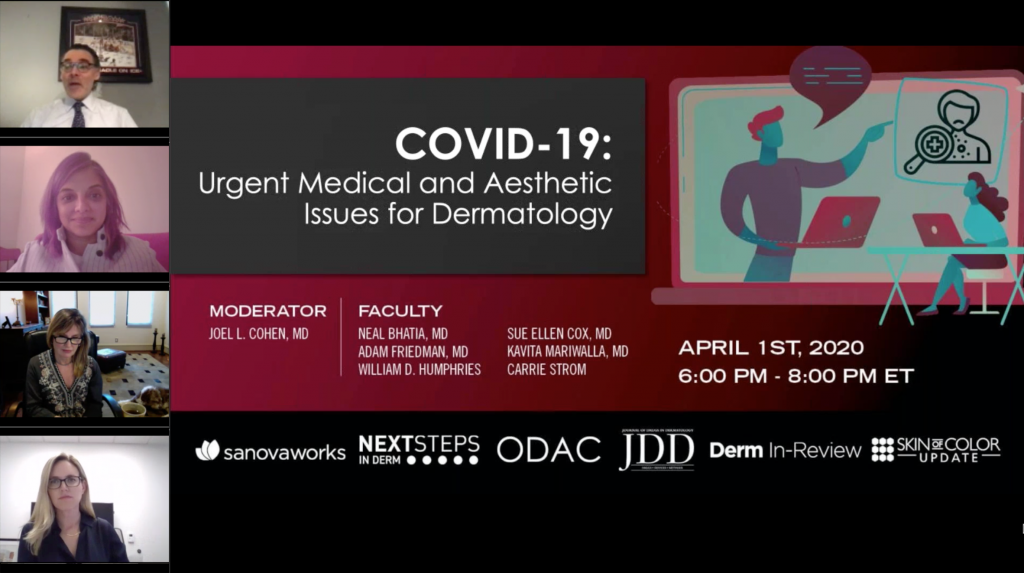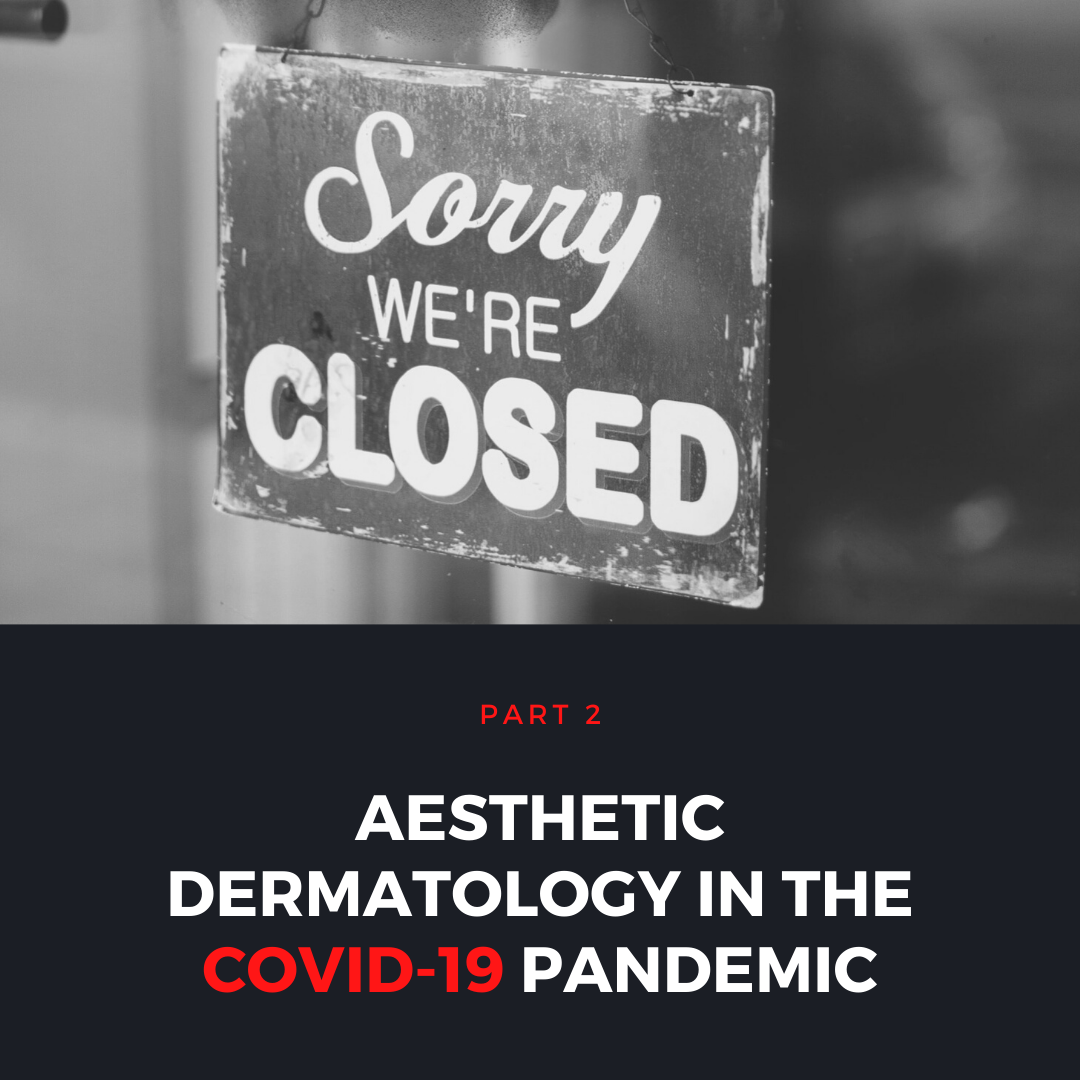This post will include highlights of information shared during part 2 of “COVID-19: Urgent Medical and Aesthetic Issues for Dermatology”, a special edition webinar hosted on April 1st, 2020 by the Journal of Drugs in Dermatology in  partnership with Next Steps in Derm and SanovaWorks. Moderated by Joel L. Cohen, MD, Director of About Skin Dermatology and Associate Clinical Professor at the University of California at Irvine, a panel of experts including Sue Ellen Cox, MD, Founder and Medical Director of Aesthetic Solutions in Chapel Hill, NC, Kavita Mariwalla, MD, and Ms. Carrie Strom, Senior Vice President of U.S. Medical Aesthetics at Allergan discussed the following topics:
partnership with Next Steps in Derm and SanovaWorks. Moderated by Joel L. Cohen, MD, Director of About Skin Dermatology and Associate Clinical Professor at the University of California at Irvine, a panel of experts including Sue Ellen Cox, MD, Founder and Medical Director of Aesthetic Solutions in Chapel Hill, NC, Kavita Mariwalla, MD, and Ms. Carrie Strom, Senior Vice President of U.S. Medical Aesthetics at Allergan discussed the following topics:
-
- The role of teledermatology in aesthetic dermatology
- Cosmetic dermatologists and a new balance of life during COVID-19
- Re-emergence of aesthetic and cosmetic dermatology after the pandemic
The opening question proposed by Dr. Joel Cohen set the tone for the discussion, “can teledermatology be used in aesthetics right now?” Not just how can we make it work, but can we make it work? In the wake of the COVID-19 pandemic, people across the globe have redirected attention towards ideas such as survival and basic needs. The service of aesthetics, and its ability to help people define self, have a flourishing self-image, and blossom one’s beauty, is having to repurpose its space in medicine. In a time where it may not be advisable to see a patient in person, let alone inject a patient, how can the cosmetic dermatologist keep their patients and practices thriving?
Aesthetic Dermatology During COVID
So, back to the question posed by Dr. Cohen, “can teledermatology be used in aesthetics right now?” “I think so … it’s tough.” Dr. Mariwalla was the first to respond. She is utilizing teledermatology and feels that it has been well received. She did acknowledge very human and intimate concerns that patients are having. Some may be struggling with their fears of contracting the potentially fatal coronavirus, while others may be feeling guilty about trying to obtain a cosmetic treatment while their family and friends are suffering. Dr. Mariwalla’s office is utilizing multiple platforms to make teledermatology work. She is using Dermio to allow patients to send pictures, Modernizing Medicine (EMA) for video chat, and Klara for secure medical communications. To afford as many people job security as possible, she is rotating staff as well as having providers take turns performing virtual visits. In addition to delaying cosmetic procedures, her practice is also delaying Mohs cases but will begin to treat some of the aggressive tumors soon. “We are just trying to keep them (our patients) out of the ER.”
Dr. Cox, however, is not offering teledermatology. Difficulties in performing a cosmetic consultation virtually or pre-selling packages did not seem to resonate with her. “I just think you really need a patient right in front of you to assess the appropriate treatment… and (even) just their personality.” Dr. Cox again engages something intimate, the personality of a patient. Cosmetic dermatology is more than optimizing lines and symmetry; it is using the skin and structure to complement the vibrant intricacies that make each person unique.
As patients are not being seen in the office, Dr. Cox is doing what she can to keep her staff engaged and employed. Her team is involved in other projects, from going through frequently asked questions, policy and procedure manuals, and consents to ensuring that they know as much as possible about the products that are offered at her practice.
From an industry perspective, Carrie Strom shared what she sees in cosmetic teledermatology on a large scale. “It’s mixed … Some people embraced it,” but for others, “it doesn’t work for their practice.” And though she does see a trend going towards offering more services virtually, she acknowledges that “you can’t give an injectable online.”
One thing is apparent: functioning in a cosmetic role during this pandemic is difficult.
Family, relationships, and life at “three-quarters pace”
“In my practice and my life, I have always been very go go go. This has been an eye-opening experience … be at three-quarters pace. It’s still going to be ok.” Dr. Mariwalla described what most physicians not on the front lines can relate to, being forced to slow down.
Let’s start with a positive about being forced to invest less time at work—more time with family and loved ones. “I think it makes you appreciate more what you have. Things can change in a second … (and this pandemic gives) an opportunity to think about what’s important in life and what’s important to you.” Dr. Cohen recounted the fun he is having with his family, and Dr. Mariwalla discussed the changes she is making with her family, cooking, and eating clean. “We’re healthy, we’re happy… and we have each other,” Ms. Strom explained as she jokingly lamented over the amount of cooking she finds herself doing lately. As these physicians talked about their loved ones and families, you could feel the joy and satisfaction that they are experiencing from perhaps a rekindled focus for these cherished relationships. However, along with the upside of time together at home comes difficulties.
Dr. Mariwalla’s husband is a cardiologist, and when working in week-long stretches, he proposed sleeping in a tent in the garage to prevent spreading the virus at home. “These are heartbreaking discussions. You don’t want to end up thinking about where you get sick … and have three babies at home. And then … you hope you make it through all this. These are discussions that otherwise healthy 40-something year-olds never imagined having.”
“It’s just very very difficult. Emotionally, this is just tearing me apart.” Dr. Cox was relating to her 20-year-old daughter, who is a general surgery resident in New York City. “She is working right now … and she doesn’t have the proper medical equipment that she should have. I have torn my office apart and mailed her every mask I have.” And even if only in a moment, Dr. Cox relayed that she is a mother first and foremost. About her safety and the work environment, she asked her daughter, “Do you think you could go to the chairman?” Her daughter responded, “No, mom, I could never leave my fellow residents.” And complementing that sentiment, her father, Dr. Rody Cox, an esteemed physician and longtime dean at UT southwestern, reminded her, “That’s what you do when you become a physician, you take care of sick people.” This sentiment has layers of depth. Unpacking it could be an article in itself. But his words show the heart of a physician. We will put ourselves in harm’s way, put our safety at odds, ask our family to sacrifice, and all in the spirit of protecting the patient.
One thing that we rarely see in leaders is vulnerability. I appreciate that the panelists were open in sharing their personal lives. Their struggles and concerns are similar to those of us also in healthcare. To watch more about how they are getting by, I recommend watching the full webinar.
And though so much time and attention are directed towards family, these leaders are contributing to dermatologists in training. With in-training exams occurring during the outbreak and board exams around the corner, Dr. Mariwalla is helping residents prepare. She is hosting a virtual meeting where she goes over surgical material for board review. “It’s been a lot of fun,” she stated. And as my dermatology program is among the many in attendance, we can certainly attest to this!
Dr. Cox said something that everyone who is passionate about cosmetic dermatology is feeling, “I’m ready to go back to work, I miss it terribly.”
Re-emergence of aesthetic and cosmetic dermatology after the pandemic
Although no one is quite sure how robustly or quickly the cosmetic industry will re-emerge, there is no doubt that it will be back. Ms. Strom was able to provide insight based on industry observations in China, which she stated was about four weeks out from lifting social restrictions. “About 75% of aesthetic practices are running,” she stated, while also referencing the “lipstick effect,” where, in the economic turmoil of 2008 and 2009, people wanted to treat themselves to small luxuries.
Moving forward, the tone will be optimistic. After restrictions are safely lifted Dr. Mariwalla will be having a “celebration of life event.” This event will allow patients to treat themselves and take advantage of big discounts. Ms. Strom also looks forward to reopening. She spoke about the “symbiotic” relationship that industry has with dermatologists and how Allergan has come alongside dermatologists in support. In addition to hosting educational webinars, she also stated that she believes companies should replace products that are on the shelf and may expire.
Right now, it seems that aesthetics in dermatology have slowed significantly. The role of aesthetic dermatologists may be more supportive in complementing those engaged in the “war” on COVID-19. At the moment, Dr. Cox, the mother of a young physician on the front line boldly stated, “when it comes to aesthetic procedures and elective surgery, we should not be doing it at all.” Dr. Mariwalla is also looking at the big picture. “I think over time we have allowed our role in the care team to be eroded … As doctors we are leaders … and having closed our offices and closed our practices, this will give us a renewed sense of purpose when we get back to opening.”
While we wait for the cosmetic world to rush back to life, we should all try to contribute. We can do so by keeping our patients home, donating gloves and masks to those on the front line, or as the CEO of Sanovaworks, Ms. Shelly Tanner, mentioned, getting more directly involved. For those feeling called to assist one of the areas most affected, New York, this link and survey can help you find a role. “As Ms. Tanner states, “The main thing is that we all come together right now. The world needs us.”
If you missed my article on part 1 of this webinar, you can read it here.

